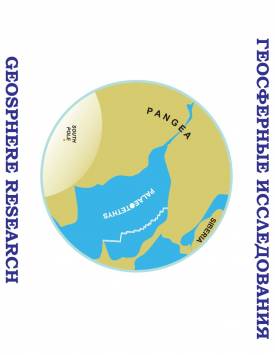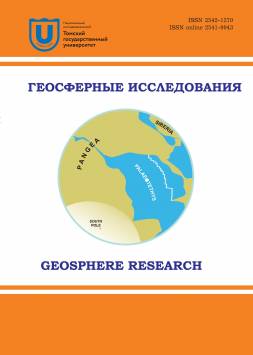Amphibole-bearing granites of the Zashikhinsky deposit (East Sayan)
The Zashikhinsky tantalum-niobium deposit is located on the territory East Sayan zone of alkaline magmatism. The deposit is caused by agpaitic granites petrochemical rocks, amphibole-bearing rocks making up more than 50% of the total represented by columbite, Nb-rutile, zircon, xenotimum-Y, gagarinite-Y. Pyrochlore, fergusonite, monazite, thorite, samarskite, bastnasite, cryolite and fluorocerite found in the rocks are obseved in small quantities and do not affect the noticeable quality of the ores and concentrates of the deposit. To assess the content of components, a quantitative X-ray fluorescence analysis of the samples was carried out on an S4 Pioneer X-ray spectrometer (Bruker, AXS, Germany). The concentrations of 35 trace elements in the rock were measured by ICP-MS method on an Element 2 mass spectrometer. The chemical composition of minerals was determined on a Superprobe JXA-8200 electron probe microanalyzer (JEOL Ltd, Japan). Measurements of the oxygen isotope composition of oxygen in quartz were performed on a Finnigan MAT 253 gas mass spectrometer. Two varieties of amphibole-containing rare-metal granites have been studied: with an acicular amphibole and with a poikilitic amphibole. The rocks have a similar composition, correspond to the composition of moderately alkaline leucogranites, correspond to high-potassium varieties, are characterized by high iron content and belong to the field of alkali-supersaturated granites. The main geochemical characteristics and mineral composition of the rocks correspond to A-type granites. The studied granites have high concentrations of most incompatible elements (Zr, Hf, Ta, Nb, Th, U, REE), and moderate enrichment in light lanthanides was observed (La/Yb(n) up to 4.16). This distribution significantly distinguishes amphibole alkaline granites from leucocratic varieties of rocks and ores of the deposit, which are characterized by higher concentrations of MREE and HREE. Melanocratic varieties of alkaline granites of the Zashikhinsky deposit contain a large amount of amphibole with a predominant role among dark-colored minerals. In granites, two morphological varieties of amphibole have a similar chemical composition and are represented by arfvedsonite with a high fluorine content. The similarity of the material characteristics of the studied rocks indicates that they belong to two facies varieties of granites, which were formed within the framework of one magmatic event from a common source. The formation of amphibole-containing granites within the framework of a single magmatic event is also indicated by the chemical composition of the main ore mineral columbite and the oxygen isotopic composition of quartz samples from these varieties of deposit rock with similar values in the range from +8.7 to +9.4 ‰ δ18O. Contribution of the authors: the authors contributed equally to this article. The authors declare no conflicts of interests.
Keywords
alkaline granites, amphibole, mineralogy, rare elements, Zashikhinsky depositAuthors
| Name | Organization | |
| Alymova Natalya V. | A.P. Vinogradov Institute of Geochemistry, SB RAS | alymova@igc.irk.ru |
| Vorontsov Аlexander А. | A.P. Vinogradov Institute of Geochemistry, SB RAS | voront@igc.irk.ru |
| Lykhin Dmitry А. | Institute of Geology of Ore Deposits, Petrography, Mineralogy and Geochemistry, RAS | lykhind@rambler.ru |
| Nikiforov Anatoly V. | Institute of Geology of Ore Deposits, Petrography, Mineralogy and Geochemistry, RAS | usn2007b@yandex.ru |
| Andreeva Olga A. | Institute of Geology of Ore Deposits, Petrography, Mineralogy and Geochemistry, RAS | oandreeva@igem.ru |
| Bychkov Andrey Yu. | Lomonosov Moscow State University | bychkov@geol.msu.ru |
| Belozerova Olga Yu. | A.P. Vinogradov Institute of Geochemistry, SB RAS | obel@igc.irk.ru |
| Posokhov Victor F. | Dobretsov Geological Institute, SB RAS | vita1@yandex.ru |
| Sotnikova Irina A. | A.P. Vinogradov Institute of Geochemistry, SB RAS | sotnikova@igc.irk.ru |
References

Amphibole-bearing granites of the Zashikhinsky deposit (East Sayan) | Geosphere Research. 2025. № 2. DOI: 10.17223/25421379/35/3
